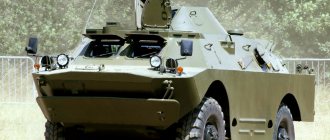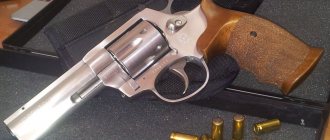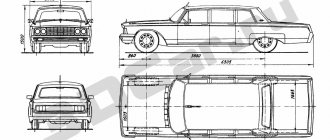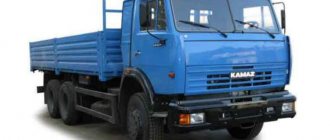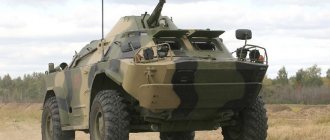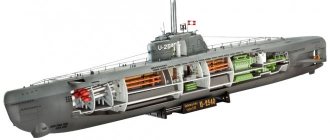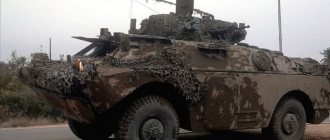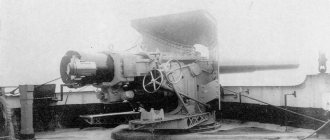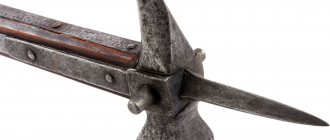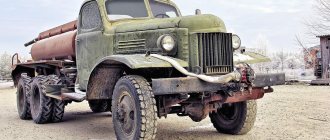Type of amphibious armored vehicle
| BRDM-1 | |
| BRDM-1 in Polish service, 1970s. | |
| Type | Amphibious armored reconnaissance vehicle |
| Place of origin | Soviet Union |
| Service history | |
| In service | 1957–1970s (USSR) |
| Used | See Operators |
| Production history | |
| Designer | Rubtsov V.K. |
| Designed by | end of 1954 - 1957 |
| Produced | 1957–1966 |
| No. built | 11,500[1] |
| Options | See Options |
| Characteristics | |
| Weight | 5.63 tons |
| Length | 5.7 m (18 ft 8 in) |
| Width | 2.25 m (7 ft 5 in) |
| Height | 2.9 m (9 ft 6 in) |
| Crew | 3–4[note 1] |
| Armor | Welded steel No more than 10 mm |
| Main weapons | no (BRDM-1 model 1957 and BRDM-1 model 1958) 7.62 mm SGMB medium machine gun on the front pintle mount (BRDM-1 model 1959 and BRDM-1 model 1960) 12.7 mm DShK 1938/46 heavy machine gun or 14.5 mm KPV heavy machine gun (Late BRDM-1) |
| Secondary weapons | no (BRDM-1 mod. 1957, BRDM-1 mod. 1958 and BRDM-1 mod. 1959) 2 × 7.62 mm SGMB medium machine guns on side pintles (optional) (BRDM-1 mod. 1960) 3 × 7.62 mm SGMB medium machine guns on pintels (two optional) (Late BRDM-1) |
| Engine | GAZ-40PB in-line petrol 6-cylinder 90 hp. (70 kW) at 3400 rpm. |
| Power/weight | 16 hp / ton (12.4 kW / ton) |
| Suspension | Leaf springs with hydraulic shock absorbers |
| Ground clearance | 340 mm[2] |
| Fuel tank capacity | 150 liters |
| Operational range | Road: 750 km (470 mi)[2] Water: 120 km (75 mi)[2] |
| Maximum speed | Road: 90 km/h (56 mph) Water: 9 km/h (5.6 mph) |
In BRDM-1
(
Bronirovanaya Razvedyvatelnaya Dozrovaya Mashina
, Armored Reconnaissance Dozor Mashina, literally "armored reconnaissance patrol vehicle".[3]) is a Soviet amphibious armored reconnaissance vehicle. It was the first Soviet reconnaissance vehicle to enter service since the BA-64 and was built on the chassis and drivetrain of the BTR-40 armored personnel carrier. This is the world's first serial combat vehicle of this class. [1]
The main advantage of the BRDM-1 at the time of its introduction was its amphibious capability, which was the main disadvantage of its counterpart, the BTR-40.[1] Another unique design feature of the machine were two pairs of chain-driven auxiliary wheels that could be lowered to provide additional traction.[1] The BRDM-1 was produced from 1957 to 1966, when 10,000 units entered service with the Soviet Union and its military allies around the world.[1] After this, it was replaced by the improved BRDM-2, which had greater amphibious capabilities, a more powerful engine and a completely enclosed turret.
History of development
During World War II and the post-war period, the Soviet Union and a number of countries adopted the concept of purpose-built armored personnel carriers. reconnaissance vehicles are designed to provide protection and moderate combat capability to reconnaissance units.[4] Several countries, such as the United States, rejected the same concept because they felt that armored reconnaissance vehicles were counterproductive in reducing situational awareness and encouraging their crews to emulate tank tactics.[5] Others, such as France, explicitly adopted heavily armed and armored reconnaissance vehicles because their respective doctrines encouraged aggressive reconnaissance.[6] Soviet reconnaissance vehicles, in contrast, were lightly armed and armored, making them effective in a passive reconnaissance role while still providing protection for the undercover crew.[4] They were still capable of more aggressive types of reconnaissance when used in conjunction with more heavily armed combat vehicles.[4]
Throughout the post-war period, the Soviet Army initially used the BA-64 in the reconnaissance vehicle role; However, the increasing obsolescence of this design led to its replacement by the BTR-40, which was designed as a general purpose transporter and armored car.[1] The Soviet Union's dissatisfaction with the BTR-40 as a reconnaissance vehicle led to design work to begin a new dedicated reconnaissance vehicle in 1954.[1] The Soviet Army ordered an amphibious armored personnel carrier capable of accommodating a crew of five, with a road speed of about 80 kilometers per hour and a road range of at least 500 kilometers.[1] In 1956, the Dedkov Design Bureau produced a prototype that used automotive components and chassis parts from the BTR-40, but featured an entirely new boat-shaped hull with amphibious capabilities.[1] It was also necessary to make a number of changes to the placement of the engine, gearbox, transmission and axles of the original BTR-40 design to accommodate the new hull.[1] This was designated BTR-40P
and was first tested by the Soviet Army in the Black Sea this year.[1]
The vehicle entered service in 1957 as the Combat Reconnaissance Patrol Vehicle
(BRDM).[1]
Service history
In Soviet service, the new BRDMs were attached to divisions and used for cover and long-range sensing.[4] In the 60-70s, reconnaissance vehicles were replenished in Soviet reconnaissance battalions with specialized versions of armored personnel carriers. BMP-1 infantry fighting vehicles that could conduct reconnaissance more aggressively and, if necessary, destroy enemy armor.[4] About 10,000 BRDMs were built for the Soviet Army and another 1,500 for export, primarily to East Germany, where it was designated SPW-40P
, and the Polish People's Republic.[1]
The vehicle was criticized for its light armor and the vulnerability of the front engine compartment during combat, as well as its open top, which exposed the crew to enemy fire when operating the weapon systems.[1] This was partially corrected by the introduction of an improved version in 1958, which had a pressurized fighting compartment and a positive pressure system, which reduced the danger from fragments and allowed the crew to explore contaminated environments.[1] However, it remained impossible to control the vehicle's weapon system from inside the hull.[1] This and other shortcomings prompted Soviet engineers to begin work on a new model of the BRDM, capable of carrying the same turret as the BTR-60 armored personnel carrier.[1] The latter brand had the engine compartment moved back, and it was much more agile; it entered service as the BRDM-2 in the mid-1960s.[1] The previous design of the BRDM has been changed. The BRDM-1
was in service with the Soviet Union and remained in service until the late 1970s, when it was discontinued.[1]
The Soviet Army exported many used BRDM-1s to its military allies, especially in Africa, from 1966 to 1980.[7] Both Egypt and Syria deployed the BRDM-1 during the Six-Day War; a number of these vehicles were captured by the Israel Defense Forces (IDF) during this conflict and were subsequently reused in unconventional operations.[8] Egyptian and Syrian BRDM-1s were deployed again during the Yom Kippur War, although in smaller numbers, largely supplanted by the more modern BRDM-2s.[8] Several captured Egyptian or Syrian BRDM-1s were transferred to the United States for evaluation purposes in the late 1970s by the Israeli government.[8] The Armed Forces for the Liberation of Angola (FAPLA) deployed several BRDM-1s during the Angolan Civil War.[8] Ugandan BRDM-1s were deployed against Tanzanian forces in Kampala during the Uganda–Tanzania War.[8]
By 2000, the BRDM-1 remained in service with the armies of eleven countries and was used almost entirely as a reserve.[9] It is believed that there are fewer than 200 BRDM-1s left in the world in 2016.[10]
Design
The BRDM-2 has a layout with the control compartment located in the front, the fighting compartment in the middle, and the engine compartment in the rear of the vehicle. The crew of the BRDM consists of four people: the commander and driver, located in the control compartment on the right and left, respectively, the gunner, located in the turret, and the observer, occupying a place on the left or right side in the fighting compartment.
Armored hull and turret
Department of Management
The control compartment is located in the bow of the hull. The control compartment houses the machine controls, as well as the following equipment:
- Seats for commander and driver; - Instrumentation; - Radio station; - Surveillance devices.
The seats have a position adjustment system. In the niche of the right front wheel there is a bracket for the DP-3B radiometer. The remote unit of the device is fixed in the housing on the front bottom sheet.
In the event of a roadside bomb being detonated at least a short distance from the BRDM, unlike the American HUMVEE, it would not receive any particular damage, unless, of course, half a ton of explosives were buried in the ground - well, then the tank would “fly”... not what a light armored vehicle. True, as for comfort... yes, the Humvee and the BRDM-2 cannot be compared. But it’s better to be hot and uncomfortable than cozy and then cold, but for good.
Description
Swimming Polish light tank BRDM-1 and PT-76 during amphibious exercises.
Note the raised trim at the front of the car. The most unusual feature of the vehicle is its four additional chain-driven support wheels, which the driver lowers to enable trench crossing. The vehicle also features a tire pressure regulation system, which later became standard on Soviet wheeled military vehicles. The initial version of the BRDM vehicle mod. 1957 had an open roof, but the next production model, BRDM arr. In 1958, a roof was added with twin hatches over the command and mechanical stations and two hatches in the stern.
The vehicle is a conventional 4×4 design, with a welded steel chassis, engine at the front and a fighting compartment at the rear. The driver sits on the left, the commander on the right. The vehicle is not equipped with an NBC system and does not have night vision equipment by default. The car has four infrared driving lights and a single white spotlight mounted on the driver's side of the vehicle. In combat, the front windshields of the BRDM-1 are protected by armored shutters with built-in vision blocks. When the shutters are in the open position, they protect the driver and commander from glare from sunlight and ensure that windshields are not blocked by rain or snow. GAZ-40PB V-8 gasoline The engine is based on the American Dodge truck engine and is connected to a manual transmission with four forward gears and one reverse gear with one dry disc clutch. Four additional support wheels, which can be lowered, improve the vehicle's maneuverability by reducing ground pressure and allow it to overcome trenches up to 1.2 meters wide. The driver can also increase or decrease the pressure in the main tires to improve performance.
The vehicle is fully amphibious, with a finishing board raised in front of it before entering the water to improve the vehicle's stability and displacement in the water, and to prevent the bow from flooding with water. In the water, the vehicle is propelled by a single jet head mounted at the rear. The water jet is driven by a main engine, which drives a four-bladed propeller. On land, the outlet for the water jet is protected by an armored flap. This flap must be removed before entering the water. While the front skin is in the stowed position, it serves as additional armor.
BRDM-1 has a maximum armor thickness of 10 mm. This is sufficient for protection against small hand fire and small shell fragments, but not against larger artillery and machine gun fragments of 0.50 in (13 mm) diameter. BRDM-1 series tires are unarmored and are especially vulnerable to punctures from any type of fire.[11]
BRDM arr. 1959 was usually armed with one 7.62 mm SGMB medium machine gun mounted in the front of the hull, for which there were 1,250 rounds of ammunition. BRDM-2 arr. In 1960, there were also mounts for two more 7.62 mm SGMB medium machine guns on the sides of the roof, but usually only one machine gun was mounted, although machine guns could be mounted at all three mounting points. Later, a 12.7 mm DShK 1938/46 heavy machine gun or 14.5 mm KPV heavy machine gun replaced the 7.62 mm SGMB medium machine gun in the front, while an additional 7.62 mm SGMB medium machine gun was mounted at the rear. It was also possible to install two other 7.62 mm SGMB medium machine guns on the sides of the vehicle.
However, the Soviet Army did not like the car for several reasons. The vehicle did not have a turret, and to operate the weapons the gunner had to open the hatch and expose himself to enemy fire. The vehicle also did not have special sights, which limited its use as a reconnaissance vehicle. These shortcomings motivated the development team to create a new vehicle that would be suitable for the modern battlefield.[12]
Performance characteristics of BRDM-1
Crew, people: 2 Troops, people: 3 Manufacturer: GAZYears of production: 1957—1966 Number of production, pieces: about 10,000, including vehicles based on it Layout diagram: power compartment in the front part of the vehicle, combined combat and control compartment in the rear
Weight of BRDM- 1
– 5.6 tons
Dimensions of BRDM-1
– Hull length, mm: 5700 – Hull width, mm: 2250 – Height, mm: 1900 for the roof, 2295 for the machine gun – Base, mm: 2800 – Track, mm: 1650 – Ground clearance, mm: 315
BRDM-1 armor
– Type of armor: rolled steel - Hull forehead, mm/deg.: 7—11- Hull side, mm/deg.: 7- Hull rear, mm/deg.: 7- Bottom, mm: 4- Hull roof, mm: 5- The front of the cabin, mm/deg.: 11- The side of the cabin, mm/deg.: 7- The stern of the cabin, mm/deg.: 7- The roof of the cabin, mm/deg.: 5
Armament of BRDM-1
– Machine guns: 1 × 7.62 mm SGMB mod. 1949
BRDM-1 engine
– Engine type: GAZ-40P- Engine power, l. pp.: 85—90
Speed BRDM-1
– Speed on the highway, km/h: 80- Speed on rough terrain, km/h: 25-30 on a dirt road, 9 afloat- Cruising range on the highway, km: 500- Cruising range on rough terrain, km: 85 at floating - Specific power, l. s./t: 15.2—16.1
– Wheel arrangement: 4 × 4 (additional wheels raised), 8 × 8 (all wheels) - Suspension type: independent on leaf springs with hydraulic shock absorbers - Specific ground pressure, kg/cm²: adjustable, 0.5—3.0 - Climbability, degrees: 42- Climbable wall, m: 0.4- Cableable ditch, m: 1.22- Cableable ford, m: floating
Options
East Germany
- SPW-40P
- East German designation for the unarmed BRDM-1.[13] - SPW-40PA
- East German variant of the armed BRDM-1 with large IR headlights.[13] - 9P111
- East German version of 9P110. Unlike the Soviet 9P110, the East German version has additional headlight protection and two fuel tank mounts at the rear of the vehicle.[13]
Hungary
- FUG
- FÚG (
Felderít Úszó Gépkocsi
- "Amphibious Reconnaissance Vehicle") - Due to its similarities to the BRDM-1, the BUG D-442 is sometimes mistaken for a modification of the BRDM-1, although several important differences reflect the independence of the design.
It has two amphibious water jet engines instead of one like the BRDM-1, powered by a Hungarian-made six-cylinder Csepel diesel engine, and the engine compartment is located at the rear. Produced in Hungary by Rába Magyar Vagon és Gépgyár and used by Hungary, Poland and Czechoslovakia. It is also known as D-442
.[14]
USSR
Polish tank destroyer 2P27 in a firing position. Note the T-54/T-55 main battle tank in the background. Tank destroyer 9P110 in the St. Petersburg Artillery Museum
- BRDM-1 arr.
1957 - standard unarmed amphibious armored reconnaissance vehicle with an open top.
It was also known under the designation BTR-40P
.[13]
BRDM-1 mod.
1958 - Standard unarmed armored reconnaissance amphibious vehicle with a roof with two front hatches.
It was also known under the designation BTR-40P
.[13]
BRDM-1 mod.
1959 - A standard amphibious armored reconnaissance vehicle equipped with a single 7.62 mm medium machine gun mount in the front of the roof.
It was also known under the designation BTR-40P
.[13]
BRDM-1 mod.
1960 - Standard amphibious armored reconnaissance vehicle with three 7.62 mm medium machine gun mounts: one in the front of the roof and one on each side of the superstructure.
It was possible to install machine guns on all three mounting positions at the same time, but this was rarely practiced. It was also known under the designation BTR-40P
.[13]
BRDM-2
- Further development of the BRDM-1.
- RBC reconnaissance vehicle with two KZO-2 flag dispensers and several detection devices, including a DP dosimeter and a semi-automatic detection device PCHR-54.
It was also known under the designation BTR-40P-RKh
.
— Command vehicle with additional R-112 radios and 3 whip antennas. Also known as
BTR-40PU
And
BRDM
.[13]
- BRDM-1U
is modified for use in vehicles. This option has a rear traffic light.[13]
- The tank destroyer is equipped with a 2K16 launcher for 3 ×3M6 "Bumblebee" (AT-1 Snapper) ATGMs. The rear of the car has been completely rebuilt. The space for reconnaissance and reconnaissance equipment has been replaced by a superstructure that houses a launcher with three 3M6 Shmel missiles. When in motion, the launcher is hidden inside the superstructure and protected by armor. Thanks to this, when the launcher is not deployed, the 2P27 looks almost like a regular BRDM-1. It even has four firing ports on both sides of the vehicle, although they cannot be controlled in this vehicle. It is almost impossible to distinguish two cars from a great distance. When the car stops, you can launch the rocket launcher. To do this, remove two steel panels at the top of the launcher compartment, open the hatch at the rear of the superstructure and lift the launcher. After this, the launcher can be launched immediately. Developed in 1958.[13]
- The tank destroyer is equipped with a 2K8 launcher on 4 ×9M11 "Phalanx" (AT-2 Swatter) ATGMs. The vehicle is exactly the same as the 2P27, but has a different missile launcher, which uses four 9M11 Phalanx. This is the logical successor to the 2P27, which entered service in 1962.[13]
- Tank destroyer with a 9K14M launcher on 6 ×9M14 “Malyutka” (AT-3 Sagger) ATGM. Production began in 1963. This vehicle, like the 2P27 and 2P32, has a superstructure in the rear where the launcher is hidden. However, due to the smaller size of the launcher compartment, the vehicle retains the characteristic rear of the BRDM-1. The launcher deployment mechanism has also been simplified. Now all that remains is to find a suitable platform and raise the launcher. One of the visually distinguishing features of this tank destroyer from the 2P27 and 2P32 after the launcher is deployed is that the latter do not have a top protection for the launcher when it is in the firing position.[13]
BRDM-2:
1 – wave-reflective shield; 2 – front hook for towing afloat; 3 – headlight; 4 – rear view mirror, 5 – night vision device illuminator; 6 — KPVT machine gun; 7 — commander’s observation device; 8 – observation niche; 9 – gaff; 10 – tower; 11 – saw; 12 – filter and ventilation unit; 13 – tow rope reel; 14 – muffler; 15 – rear hook for towing afloat; 16 – water-jet propulsion valve; 17-rear hook for overland towing; ^-additional retractable wheel; 19 – balancer of the additional wheel; 20 – wheel brake drum cover; 21 – front wheel spring bracket; 22 – front hook for towing overland
Placement of observation devices for the vehicle commander: 1 – handle for opening and closing the armored cover of the inspection hatch; 2, 6 – TNP-B devices; 3 – windshield; 4 – TPKU-2B device; 5 – device TNPO-115; 7 – BT-6-26 power supply unit for TVNO-2B device
Placement of driver monitoring devices: 1 - TNP-B devices (3 pcs.); 2 — device TNPO-115; 3 - central device TNPO-115, instead of which the TVNO-2B device is installed; 4 – right TNP-B device; 5 – handle for opening and closing the armored cover of the inspection hatch; 6 – windshield in the inspection hatch; 7 – high-voltage cable with a connector in the installation
Turret machine gun installation: 1 – turret stopper; 2 – turret electrical panel; 3 – cradle stopper bar; 4 – box holder latch; 5 – sleeve tape collector; 6 – cradle stopper bar pin; 7 – PKT electric release button; 8 – flywheel handle for the turret rotation mechanism; 9 – KPVT electric trigger button; 10 – PP-61 AM sight; 11 – lifting mechanism brake handle; 12-KPVT reloading handle; 13 – lifting mechanism flywheel handle; 14 – windshield wiper handle; 15 – tower brake handle
S. SHUMILIN
Operators
Map of BRDM-1 operators in blue with former operators in red
- Republic of the Congo[9][10]
- Cuba: 50[7]
- Eritrea[10]
- Guinea: 10[7][10]
- Kazakhstan[9]
- Mozambique: 51;[7] > 28 commissioned in 2013.[15]
- Sudan: 5[7][10]
- Transnistria[16]
- Vietnam: 50[7][10]
- Zambia: 44[7][10]
Former operators
- Afghanistan: 50[7]
- Albania: 15[7]
- Angola[17][8]
- Bulgaria: 150[7]
- Czechoslovakia: 124[18]
- East Germany: 150[7]
- Egypt: 200[7]
- Ethiopia: 50[7]
- Indonesia[7]
- Israel[8]
- Libya: 60[7]
- Oman[19]
- Peru: 12[7]
- Poland: 900[7]
- Romania[20][21]
- Soviet Union: 10,000[1]
- Syria: 100,[7] retired until 2010s[22]
- Tanzania: 30[7]
- Uganda: 98[7]
Modifications
Wheeled all-terrain vehicles BRDM-2 are produced in several modifications. They were produced in various countries.
At the Arzamas Machine-Building Plant, in addition to the basic version, the BRDM-2M(A) version was also produced. In this model, wheeled side mechanisms are replaced with trapezoidal doors. This made it possible to reduce the weight of the vehicle. The suspension is borrowed from the BTR-80. The power unit is a turbocharged diesel engine. Its power is 136 hp. With. The BRDM-2A version is supplemented with two types of radio stations to choose from. The armament is a machine gun (7.62 and 14.5 mm).
Several modifications were released on the territory of Ukraine. In 1999, the BRDM-2LD version with a new engine was assembled in Nikolaev. This model was used during the military conflict in Kosovo. 6 years later, another modification was released in Nikolaev - BRDM-2DI "Khazar". An Iveco diesel engine with preheating, a thermal imager and new weapons were installed.
Two more modifications were assembled in Kyiv. The first was called BRDM-2DP. It was lighter in weight, for which the side mechanisms for increasing cross-country ability were removed. Instead, a new engine, a structure for overcoming trenches, and a door on the side of the body for paratroopers were installed. The set of weapons has changed. The second Kiev modification appeared in 2013. Additional wheels have been removed. A radio station and a diesel engine with a power of 155 hp were added. s., marker lights at the rear and front, hatches for paratroopers. Combat modules have been changed.
Poland proposed several modifications. The first BRDM-2M-96I appeared in 1997. It featured a new braking system and a 6-cylinder Iveco diesel engine. The second modification appeared in 2003. It was named BRDM-2M-96IK “Jackal”. A new and improved Iveco diesel engine with 6 cylinders was installed. The car was equipped with a radio station, air conditioning, and anti-cumulative lattice screens. The caliber of the installed machine gun has been changed. The latest modification produced in Poland is the BRDM-2M-97 “Zbik B”. In addition to the new six-cylinder Iveco diesel engine, this model was equipped with a new transmission and other additional equipment.
Another modification was assembled in Belarus. It was named BRDM-2MB1. Additional wheels and propellers were removed on it, allowing it to travel on water. The model was equipped with a 155-horsepower diesel engine, a radio station, video surveillance, and hatches for paratroopers on the sides of the body. Changed weapons. The crew has been increased to 7 people.
In 2013, Azerbaijan proposed its version of “Zubastic”. The jet propulsors and additional wheels have been removed. A power unit with a capacity of 150 hp is installed. With. Improved mine protection. Hatches for paratroopers, a machine gun, and turrets for military modules (grenade launchers of various calibers, a double-barreled gun) were installed.
Kazakhstan proposed its modification in the same year. The power unit was replaced with an Iveco diesel unit. Bridges have been replaced. They were taken from the BTR-80. Due to this, the track has increased. The spring suspension remains from the basic version. The modification was called BRDM-KZ.
There was its own modification in the Czech Republic (LOT-B, LOT-V), Serbia (Kurjak).
